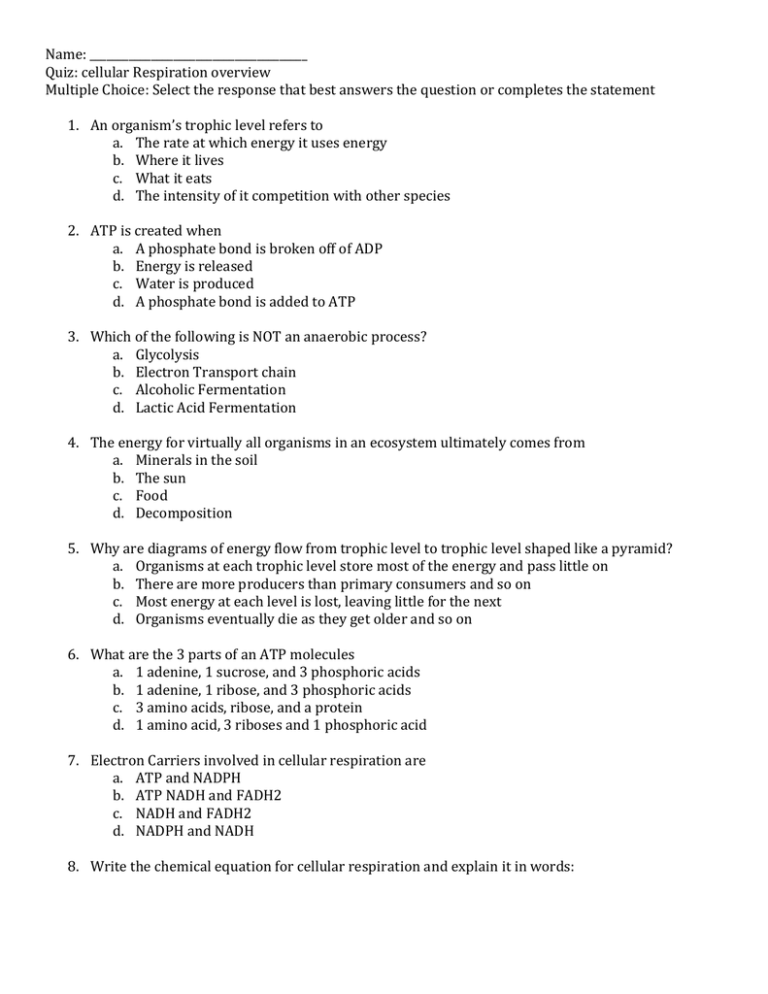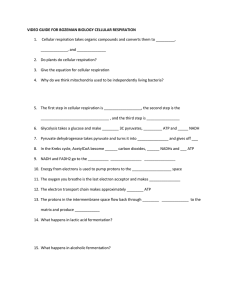Name: Quiz: cellular Respiration overview Multiple Choice: Select
advertisement

Name: _______________________________________ Quiz: cellular Respiration overview Multiple Choice: Select the response that best answers the question or completes the statement 1. An organism’s trophic level refers to a. The rate at which energy it uses energy b. Where it lives c. What it eats d. The intensity of it competition with other species 2. ATP is created when a. A phosphate bond is broken off of ADP b. Energy is released c. Water is produced d. A phosphate bond is added to ATP 3. Which of the following is NOT an anaerobic process? a. Glycolysis b. Electron Transport chain c. Alcoholic Fermentation d. Lactic Acid Fermentation 4. The energy for virtually all organisms in an ecosystem ultimately comes from a. Minerals in the soil b. The sun c. Food d. Decomposition 5. Why are diagrams of energy flow from trophic level to trophic level shaped like a pyramid? a. Organisms at each trophic level store most of the energy and pass little on b. There are more producers than primary consumers and so on c. Most energy at each level is lost, leaving little for the next d. Organisms eventually die as they get older and so on 6. What are the 3 parts of an ATP molecules a. 1 adenine, 1 sucrose, and 3 phosphoric acids b. 1 adenine, 1 ribose, and 3 phosphoric acids c. 3 amino acids, ribose, and a protein d. 1 amino acid, 3 riboses and 1 phosphoric acid 7. Electron Carriers involved in cellular respiration are a. ATP and NADPH b. ATP NADH and FADH2 c. NADH and FADH2 d. NADPH and NADH 8. Write the chemical equation for cellular respiration and explain it in words: Modified true/false: Correct the false statements 9. _________________ Only heterotrophs conduct cellular respiration 10. _________________The reactants of respiration are the same as the products for photosynthesis 11. __________________ADP stores more chemical energy than ATP 12. _________________ Cellular respiration is a rapid release of chemical energy from glucose 13. __________________ An organism stores 90% of the energy it acquires 14. __________________ Aerobic respiration requires oxygen Short answer: use complete sentences to respond to the following questions. 15. Draw and label the structure of the mitochondria. Label where each cycle of cellular respiration occurs. 16. Oceanographers have suggested slowing the rate of global warming by fertilizing the ocean to increase the growth of algae. How would this reduce global warming? Be specific. 17. ATP is used to power your muscles as you turn the pages of a book. Where did the energy from ATP come from? Trace the ATP molecules back to the sun. How does the movement of energy through ecosystems compare to the movement of matter?







